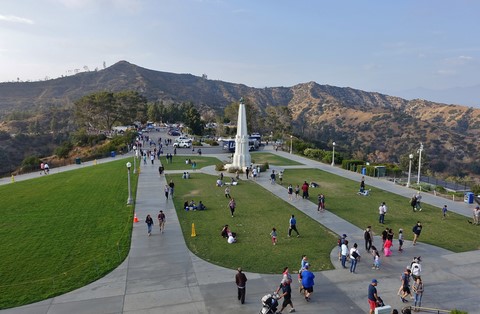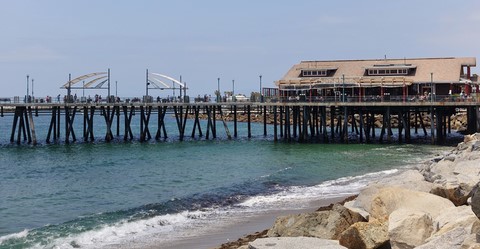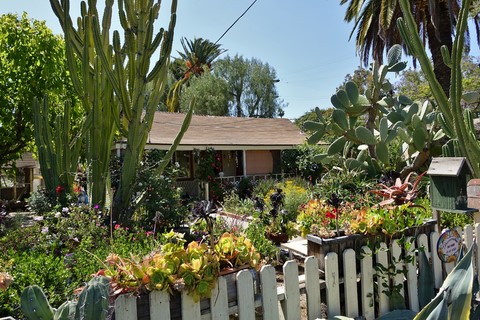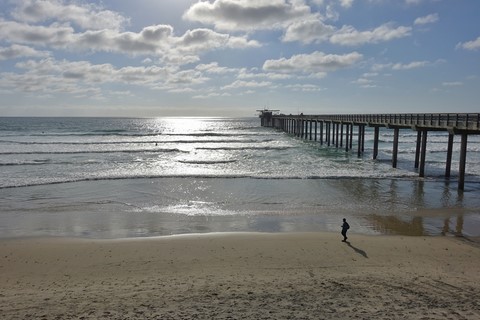Southern California
You can click on pictures to enlarge them
Los Angeles
For our return in the City of Angels, we did not want to rush immediately in the hustle and bustle of the town. We wanted first to contemplate it from a distance and with a bird's eye view, to be conscious again of its immensity. It seemed to us that Mulholland Drive was the perfect place for it. Picturesque road that stretches over many kilometers, it joins the valley to the Pacific Coast north of L.A. along a tortuous path, in places on the edge on the ravine. Its most dangerous portions force you to slow down, which allows you to admire a breathtaking panorama with a view from above. It is mythical and driving along it is some kind of pilgrimage. It would be a pity to spend many days in Los Angeles without driving at least on one of its sections. We made stops, notably in Mulholland Scenic Overlook, and in Universal City Overlook, which offers a view of San Fernando Valley and Verdugo Hills.
Then, we came down to join Los Feliz, an essentially residential district in the valleys east of the city. There, imposing houses with an old-fashioned charm - some of them in an Arts & Crafts style - run along, most of them in the heart of wide green and shaded properties. We visited Griffith Park, a huge 17 km² urban park. It has an old carousel and a zoo. But its main attraction remains naturally the Griffith Observatory (photo), beautiful Art Deco building with an impressive telescope with focusing wheels. It opened in 1935 in order to allow the general public to have access to astronomy. We joined it walking along one of the numerous trails in the park. It includes a planetarium, a laserium, and the Hall of Science. On its alley stands a bust of James Dean, in tribute to the scenes of the legendary «Rebels without a cause» filmed there. Its terraces and its panoramic viewpoints offer an unrestricted view of the city, especially the must-see Hollywood Sign that we saw again three years after with a lot of pleasure, from a different angle. Not far stands the Greek Theatre where many shows take place.
Naturally, it was impossible not to go back to Hollywood after we had the feeling of touching the Hollywood Sign with our fingertips from the surroundings of the Griffith Observatory. So we spent the night again in Hollywood Boulevard, more specifically on the mythical Walk of Fame, that we found still so hectic. We made a stop before at the Hollywood & Highland Center to have dinner. We wanted especially to go to the famous TLC Chinese Theatre, which entrance is a splendid Chinese pagoda in front of which some stars left their handprints and footprints in wet cement. Indeed, we ignored in 2013 that we were very close to that place which is famous all around the world. We have been aware of that later, and we were keen on catching up with it. We lingered there, and then we crossed the boulevard to admire the amazing El Capitan Theatre as well, which entrance and sumptuous hall in a Spanish Colonial style are worth the visit alone. Not far stands the Dolby Theatre, which is from now on the official location of the Oscar Awards Ceremony. The Madame Tussauds wax museum is also a must-visit, with its larger than life stars. It puts up a significant competition to the Wax Museum that is located a few tens of meters further, on the other side of North Highland Avenue. The Hollywood Museum, superb Art Deco building, houses numerous pieces about the seventh art’s biggest hits from its early days to the present time. Finally, we left the fervor of Hollywood to drive again along Mulholland Drive. At night, the road is particularly fascinating. Its darkest sections have a very entrancing mysterious nature. And, after a bend, when the thick darkness clears to offer a breathtaking view of the sprawling city lights, we realize more than ever the City of Angels hugeness.
The «Beach Cities» in Los Angeles
In 2013, we had no time to go to Hermosa Beach. Yet, we were keen on doing that, for we had heard about it as one of the nicest beaches in Southern California. Indeed, «hermosa» means «beautiful» in Spanish. So, it was part of our priorities during our return in Los Angeles. Unfortunately, we were deceived. Admittedly, the beach is wide and favorable to the practice of many sports: surf, stand-up paddle, beach-volley and others. But the buildings that run along it have nothing special according to us. The pier is quite ordinary. The part of the town we visited has little to offer aesthetically. It is rather its atmosphere that makes of Hermosa Beach what it is: a very lively and unpretentious seaside resort, where you can find cheap bars and restaurants. Its night life is rather appreciated. As we moved away from the sea front, we saw nevertheless nice wooden houses very colored and full of charm, as well as beautiful murals. One of them depicts the small town the way it was in 1924, with its superb period buildings, which justified its name more than it does today.
We came back with a lot of happiness to Redondo Beach (photo). Indeed, that is where we started our trip in 2013, thus realizing our dream to visit that extraordinary country. That is why it matters so much to us: it will be forever the first, our anchor point in California, even in the U.S.A. generally. We will always carry it in our hearts. It almost did not change within three years, to our great joy. Its yellow sand beach - which offers a nice view of the Palos Verdes Peninsula – is still so pleasant and popular, especially the part of it located in front of Veterans Park. You always visit the port and the pier under flights of pelicans, and it is constantly livened up by the screams of seals, eared seals and sea lions, which gives the place an undeniable character. Unpretentious city, it is very likeable. It is full of authenticity and sweetness of living, and it makes us want to come back.
Newport Beach
Located in Orange County, it is a very charming seaside resort and a great place to live in. We started the visit with Balboa Island (photo), located in Newport Bay, and linked to the continent by a small bridge. We took a walk in its pleasant streets, notably the promenade along the port with its nice villas the ones next to the others, which leads to closeness between inhabitants - very wealthy - so that they live in perfect harmony. Some are in Victorian style, others are more modern. Most of them are surrounded by small gardens, which brings additional greenery to the flower beds and the shrubberies that run along the promenade. Just in front, small private boats are moored to pontoons, whereas others float peacefully in still water. On the opposite shore stands the beautiful Balboa Pavilion, built in the early 20th century in a Queen Anne Revival Victorian style.
Then, we took the small ferry to Balboa Peninsula with our vehicle for a picturesque crossing that lasted a few minutes in a friendly atmosphere. There, we ended up in front of the Pacific Ocean after we crossed a very nice residential area with opulent houses surrounded by wider gardens than in Balboa Island. At the end of the Balboa Pier stands the very first restaurant of the Ruby's Diner chain, which opened in the early 1980's. For the record, we had our very first breakfast in America at Ruby's Diner in Redondo Beach in 2013. There, we were seduced by the nostalgic charm of the 1950's, and the period decoration with white Formica tables and red moleskin seats reminding us many movies scenes. That is why it has a sentimental value for us.
The ocean was very calm that evening, and the enthusiasts for water gliding sports that we are could not attend the formidable rage of the Wedge, dangerous and powerful shorebreak with which only the most experienced compete practicing surf, bodyboard, skimboard or stand-up paddle. For those who are not so adventurous, Newport Beach has good and more ordinary spots as well.
However, we caught up with a wonderful typically Southern-Californian sunset. J.R. and our friend admired it from a long rocky breakwater. As for me, I could not resist moving away to go up on a lifeguard stand and make myself comfortable to have a privileged view. The outlines of the other lifeguard stands in a row - as well as those of the Balboa Pier on the background - distinguished from the blazing evening colors in a stunning contrast. We had the feeling of finding ourselves before one of those numerous sunsets that we had seen over and over again in movies or TV series taking place in California: the kind of scene that made us dream every time, and tempted us to go there one day and just live it. It has been achieved since that unforgettable moment.
San Juan Capistrano
The superb San Juan Capistrano Mission - established in the late 18th century - gave its name to that small town also located in Orange County. It is one of the most beautiful among the twenty one missions established in California. It is endowed of an entrancing charm, and it tempts to peace and spirituality. Be aware that it includes the oldest building in the state: the modest Serra Chapel that houses a splendid golden altar in Baroque style. It is surrounded by a small cemetery. Gardens flourish in a mosaic of bright colors, overlooked by some palm trees and orange trees. Ornamental fountains in Moorish style complete that idyllic picture where we feel like lingering while dreaming. The San Juan Capistrano Mission Basilica is part of it, as its name suggests, but it is located a short stroll away from it. Its sober immaculate façades hide a richer interior decoration, notably the big altarpiece and the altar carved out of cedar wood and covered with golden leaves.
The rest of the small town is very pleasant. You can find here and there other ornamental fountains in Moorish style. The station is worth the visit alone: built in the late 19th century in Mission Revival style with red bricks, it matches perfectly with the rest of the area. Feel free to go beyond the railroad crossing and reach Los Rios Street (photo). You will be wondered by the very typical wooden houses near to the art galleries, the whole in a green setting that covers the place with a very pleasant shadow. Their lush gardens, as well composed of armfuls of fresh flowers as succulents, are adorned with various works of art, the whole on a rather limited space. The result is a lovely jumble, so charming and carefree, which gives the place an undeniable character. Thus, each one of those houses seems to carry the personality of people who live in.
San Diego
It is the second city in California, which is not San Francisco as we could think. It was built on a site mainly composed of deserts and wooded hills on the edge of the Pacific Ocean. Its main attractions are beaches, historic districts and the famous Balboa Park. It has a Bay which panorama is an incongruous mix of glass skyscrapers, Art Deco palaces and Moorish towers.
More secure and less polluted than Los Angeles, life there is also less expensive. It is famous for its big amusement parks with family tradition, but it has much more to offer. It abounds in riches. Many museums add to historical sites, which gives it an undeniable cultural interest. Its parks and its beaches compete in beauty. Located a few kilometers from the border, it has always maintained its important Mexican heritage
The climate there is very pleasant: globally much sunny and mild, it is rarely raining. However, the weather can sometimes be patchy on the seafront, when a sudden mist drapes beaches with its thick and persistent grayness, and brings moreover a little bit of coolness. But it ends up clearing in the middle of the day.
In the City Center, Downtown, Embarcadero and Little Italy districts were in the beginning the seamen quarter that was damaged, and then has been restored. The Manchester Grand Hyatt building rises on the bay, very modern with a little touch of Victorian style. A nice promenade runs along the Embarcadero Marina Park. It has many pontoons. There, you can admire nice yachts. The nautical theme is recurring in the district modern architecture: the San Diego Marriot Marquis & Marina depicts two boats that return to port if you observe it through a given angle. As for the San Diego Convention Center, its outline reminds a liner. You have understood; San Diego is primarily a city with harbor tradition: in front of the Maritime Museum, you can see magnificent sailboats moored to quays. Cruise ships draw alongside the Broadway Pier, as well as the ferry to Coronado Island. The USS Midway Museum allows you to visit the famous World War II aircraft carrier.
Gaslamp became the artists' haven. There are notably restaurants and cafes that attract crowds of people along Broadway. Art galleries, theaters, museums and shops are not forgotten. Buildings and streetlights - which gave the district its name - from the 19th century mix with modern buildings and give the place a certain authenticity and a historical value. A modern architecture that is sometimes daring and innovative mixes with older styles like Victorian or Far-West, which forms a very eclectic set.
Balboa Park is a must-see: it is a huge exotic park overlooking the ocean. It groups together very varied museums, theaters, gardens (including the beautiful Japanese Garden), a golf course, cycle lanes, picnic and hiking areas, and especially the famous zoo: it is unique in the world with more than 4000 animals, its tropical and subtropical areas, its exceptional scenery and environment made to recreate the occupants’ original environment. The Botanical Garden is as varied as abundant. It has many tropical plants, including carnivorous plants. It is housed by the Botanical Building: made of wooden slats, that one is really beautiful with its curved lines. The Spreckels Organ Pavilion enjoys a refined architecture. The very imposing organ it houses under its vault is a true wonder. You can see from the distance the harmonious outline of the California Tower, which proudly overlooks a sumptuous architectural ensemble in Hispanic Colonial style.
Coronado Island is a superb peninsula you can get to from the city center on the ferry, or by road driving across the impressive San Diego-Coronado Bridge, opened in 1969. It is linked to the continent by an 11 kilometers isthmus: the Silver Strand. It is mainly residential and superb modern villas are near magnificent Victorian houses. According to many people, Coronado Central Beach is one of the most beautiful beaches in the U.S.A. Its Southern part is more attractive: indeed, when the tide goes out, it lets resurface the Monte Carlo shipwreck - that ran aground in the 1930’s - like a ghost from the past. But above it all, it is where the sumptuous Hotel Del Coronado - in an extravagant Victorian style - majestically rises. Its immaculate façades and its red roofs - especially the one of the Crown Room, with an octagonal shape - are well known all around the world. It is a real jewel of architecture that we visited a long time. The reception hall is just fabulous. It is mainly made of varnished oak wood. Its ceiling, its columns and its interior balconies will leave you speechless. Its terrace offers a breathtaking view of the ocean. It was the first in the world to install electric illumination. It was made famous in 1959 thanks to the movie «Some like it hot» with Tony Curtis, Jack Lemon and the unforgettable Marilyn Monroe. Yet, the part of the movie which concerns the Hotel Del Coronado takes place… in Florida!!?
Facing Coronado Island, Point Loma, superb peninsula covered with cliffs, has two major assets. First, there is Whale Overlook, a perfect spot for whale-watching. However, it is limited to the winter period. The other attraction is the beautiful Cabrillo National Monument, located on the highest point of the peninsula. One might as well say that it offers an unrestricted panoramic view. It was named after the explorer who discovered the San Diego Bay in the 16th century. A four meters high statue of him proudly rises there. Nearby stands the Fort Rosecrans National Cemetery, very wide military cemetery which white graves line in a perfect grid on impeccable red lawns. Old Point Loma Lighthouse is one of the oldest lighthouses in California, built in the mid 19th century. It closed decades ago but you can visit it, especially since it is very well preserved. Finally, the Sunset Cliffs spot is much appreciated by surfers.
Old Town has a considerable historical significance. And for good reason: there are quite simply the first European facilities in California. They date from 1769, even though the site was discovered by the Spanish nearly in the mid 16th century. However, it only prospered during one century, when they decided to move the core of the city to the bay. Shortly after, a fire sealed the fate of Old Town. But they started to restore it from the late 1960's, conscious of its inestimable value. The Old Town San Diego State Historic Park recounts its history. Most of buildings are made from adobes that surround a garden. Presidio Park includes the very first of the 21 missions built in California: the Mission San Diego de Alcalá. Heritage Park is a site composed of restored houses and cottages in Victorian style.
La Jolla is a very charming small opulent seaside resort that includes among others the University of California San Diego and the Torrey Pines golf course. It is home to many different architectural styles. The atmosphere there is very pleasant and if you mingle with locals and some visitors, you will be quickly in a contagious good mood, notably on Scripps Beach (photo) where we lingered. On the sand, facilities are available to the public to have its own barbecue. The Torrey Pines State Natural Reserve offers much appreciated trails. The entrance is free but parking is expensive. However, there are some free parking lots outside the site… for the first come or the luckiest… Various viewpoints offer breathtaking panoramas. The same can be said about the one in Mount Soledad, a little further south. It is a monument dedicated to military casualties fallen in battle during the various contemporary wars in which the Commonwealth participated. Perched on the top of a hill, it is surmounted by a big white Latin cross. We reveled in that unique view for a long time, and then we took the direction of La Jolla Cove entering a winding road in the heart of quiet residential areas. Outstanding properties surrounded by lush gardens extend across it and enjoy a looking down upon the beautiful cove. The whole was bathed in the blazing colors of a sumptuous sunset. Much photogenic, it is one of the nicest beaches in Southern California. Seals, eared seals, sea lions and pelicans do the show and contribute to the friendly atmosphere of the place. Leopard sharks sometimes invite themselves, but they are harmless to humans. Finally, we had dinner at Brockton Villa Restaurant. It is a white wooden building nestled on a cliff; you reach it from a stairway. It offers a stunning view of the cove. As we chose a table outside on the wide balcony, we had front-row seats. And then, we returned to Mount Soledad - by night that time - to admire the city lights that extended in the distance.
Published on October, 28th 2017








